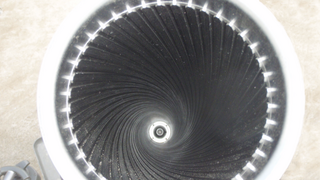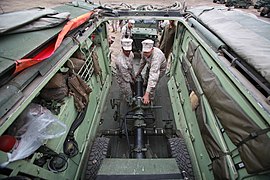Heavy mortar
| Mortier 120 mm Rayé Tracté Modèle F1 | |
|---|---|
 | |
| Type | Heavy mortar |
| Place of origin | France |
| Service history | |
| In service | French Army |
| Used by | See Operators |
| Wars | Gulf War Lebanese Civil War War in Afghanistan Operation Serval Russo-Ukrainian War |
| Production history | |
| Designer | Thales, Thomson-Brandt |
| Manufacturer | Thales, TDA Armements (France), Thomson-CSF/Daimler Benz Aerospace (Germany), Hotchkiss Brandt (Netherlands), Howa (Japan) |
| Produced | 1961–present |
| Specifications | |
| Mass | 582 kg (1,283 lb) |
| Barrel length | 2.8 m (9 ft 2 in) |
| Crew | 4 gunners, 2 vehicle crew |
| Shell | 18.7 kg (41 lb) |
| Calibre | 120 mm (4.7 in) NATO mortar round |
| Carriage | wheeled |
| Elevation | 30–85° |
| Traverse | ±14° from centreline |
| Rate of fire | 18 rounds per minute (maximum) 6 rounds per minute (sustained) |
| Effective firing range | 8,140 m (8,900 yd) with standard projectile 12,850 m (14,050 yd) with rocket-assisted projectile |
The MO-120 RT (factory designator) or MO-120-RT is a French heavy mortar. The RT in the designator stands for rayé, tracté, which means rifled, towed. The MO-120-RT is currently used by the French Army (where it is known as RT F1 or Mortier de 120 mm Rayé Tracté Modèle F1—"120 mm rifled towed mortar, model F1"), and has also been exported to more than 24 foreign countries or in some cases, produced under licence. It is issued to artillery units, where it complements artillery guns and systems; although infantry units operate it in some countries.
A vehicle-mounted and automated mortar system derived from the MO-120 RT, known as the 2R2M is in service with a number of nations.
Design
The MO-120 RT uses 120 mm rounds with a range of 8.2 km (5.1 mi) and the PRPA (RAP-Rocket Assisted Projectile) with a range of 13 km (8.1 mi). The weapon can be fired either by dropping the round down the tube (after aligning of the rifling bands) resulting in an automatic firing once the bomb hits the tube base, or by a controlled firing by dropping the bomb down the tube and pulling on a lanyard that will in turn set off the triggering mechanism in the base of the tube.
Fired mortar rounds can reach as high as 4,000 m (13,000 ft) and hit the ground with an effective kill radius of 76 m (249 ft).
Service

In French service, this weapon is normally towed by the VTM 120 (Véhicule Tracteur Mortier de 120 mm), a wheeled armored vehicle that is a derivative of the VAB 4×4 series of armored personnel carrier. Towing is accomplished by a towing hitch that is screwed onto the muzzle of the weapon. The VTM 120 also carries 70 rounds for the mortar and offers basic ballistic protection from small arms fire and shrapnel for the crew. The RT-61 can also be towed by the AMX-10 TM (Tracteur de Mortier), which is a version of the AMX-10P tracked APC or the future French Scorpion SERVAL Vehicle.
In France, the mortars which originally equipped infantry regiments, have now all been transferred to the artillery regiments, where they augment the 155 mm towed artillery.
The manufacturer is Thales, with former company names TDA Armements, Thomson-Brandt, as mentioned above, Thomson-CSF/Daimler Benz Aerospace (France/Germany), and Hotchkiss Brandt (The Netherlands) as the "HB Rayé".
Variants
Turkish version
In Turkey, a variant was derived and manufactured by MKEK as the HY 12 mortar. It is towed by a Unimog light truck, carrying a crew of 6 with 60 mortar rounds. MKEK produces the "Mod 209 High-Explosive (HE) bomb" ammunition for this.
Japanese Type 96
The Japan Ground Self-Defense Force operate the MO-120-RT both in the towed configuration as well as mounted in a vehicle, the Type 96.
-
Towed configuration in Japanese service. Prime mover is Toyota Mega Cruiser.
-
 JGSDF version Type 96 Heavy mortar
JGSDF version Type 96 Heavy mortar
-
 JGSDF SP Type 96 variant
JGSDF SP Type 96 variant
2R2M
Main article: 2R2M mortar
The 2R2M is a vehicle-mounted and automated mortar system derived from the MO-120 RT.
M327 expeditionary fire support system
The United States Marine Corps began looking for an expeditionary fire support system (EFSS) in 2001 after the start of operations in Afghanistan exposed their lack of expeditionary artillery lighter than a 155 mm howitzer but heavier than a 60 mm mortar. Early on, the 120 RT weapon became tied to the development of the MV-22 Osprey, which would contain a Growler ITV jeep that would tow it; both efforts were troubled and experienced delays. The EFSS was first used operationally in Afghanistan in February 2011, firing an M1105 illumination projectile. The full EFSS was introduced in 2009, consisting of two light vehicles, one towing the mortar and the other an ammunition trailer, that fit inside an MV-22 or CH-53E Super Stallion; an EFSS battery is made up of roughly 50 marines.
From 2011 to 2015, the Marines and Raytheon developed the precision extended range munition (PERM) for the EFSS, a GPS-guided round that delivers greater range and better accuracy. The 35 lb (16 kg) round increased range from 8 km (5.0 mi) to 16 km (9.9 mi), falling within 10 m (33 ft) of the target and as close as two meters, costing $18,000 each, and having 2.5–3 times more lethality. The extra range came from tail fins for stabilization and canards near the nose to make in-flight adjustments and make it glide as it descends, and the greater lethality was a result of this flight path; normal artillery rounds impact at a 45-degree angle, which blows the top half of the round straight up into the air, but descending at a sharp angle places more energy and fragmentation directly on a target. It was even capable of hitting reverse slope positions by shaping its trajectory. Greater accuracy also reduces logistical burdens, as using fewer rounds to destroy one target means a unit can last longer without needing resupply. The PERM was to begin fielding in 2018. Raytheon planned to add semi-active laser (SAL) guidance to PERM rounds to enable them to hit moving targets.
By December 2017, the U.S. Marines had divested the EFSS. With the Marines working to extend the range of their artillery arsenal, the EFSS' limited range was not seen as well suited for future missions, so it was chosen for divestment in favor of moving more resources for precision fires. The role was later filled in 2021 by the Hero-120 loitering munition launched from various vehicles.
-
 M327 mortar rifling
M327 mortar rifling
-
 M327 mortar sight
M327 mortar sight
-
 M327 120 mm rifled towed mortar
M327 120 mm rifled towed mortar
-
 USMC M327 transported internally by an amphibious assault vehicle
USMC M327 transported internally by an amphibious assault vehicle
-
 USMC high-explosive round showing rifling
USMC high-explosive round showing rifling
-
 A MO-120 RT of the Cypriot National Guard
A MO-120 RT of the Cypriot National Guard
Operators
 Belgium: 52 delivered in 1965–1966.
Belgium: 52 delivered in 1965–1966. Cameroon: 16 delivered in 1973.
Cameroon: 16 delivered in 1973. Colombia: 38 Turkish HY1-12 delivered in 2009.
Colombia: 38 Turkish HY1-12 delivered in 2009. Cyprus: 114 delivered in 1990–1991. 112 in service in 2016.
Cyprus: 114 delivered in 1990–1991. 112 in service in 2016. Djibouti: 20 delivered in 1981.
Djibouti: 20 delivered in 1981. Gabon: 4 delivered in 1986.
Gabon: 4 delivered in 1986. France: 128 in 2016.
France: 128 in 2016. Italy: 139 delivered between 2000 and 2004. The Military Balance gives 142 in service as of 2016.
Italy: 139 delivered between 2000 and 2004. The Military Balance gives 142 in service as of 2016. Japan: 462 delivered between 1990 and 2017.
Japan: 462 delivered between 1990 and 2017. Kuwait: ~12 in service.
Kuwait: ~12 in service. Kurdistan: Aided By France To Peshmerga Forces To Fight ISIS, Also Captured From The Old Iraqi Military During Operation Iraqi Freedom.
Kurdistan: Aided By France To Peshmerga Forces To Fight ISIS, Also Captured From The Old Iraqi Military During Operation Iraqi Freedom. Lebanon: 24 delivered in 2012.
Lebanon: 24 delivered in 2012. Mexico: 32 delivered in 1988, still in service.
Mexico: 32 delivered in 1988, still in service. Netherlands: 145 delivered in 1966–1968
Netherlands: 145 delivered in 1966–1968 Pakistan: In service with Pakistan Army and Frontier Corps.
Pakistan: In service with Pakistan Army and Frontier Corps. Qatar: 200 in service
Qatar: 200 in service  Saudi Arabia: 200 delivered in 1990–1991 and 25 2R2M in 2009–2010, both used by the National Guard.
Saudi Arabia: 200 delivered in 1990–1991 and 25 2R2M in 2009–2010, both used by the National Guard. Turkey: 127 deployed in Northern Cyprus as of 2016.
Turkey: 127 deployed in Northern Cyprus as of 2016. Ukraine: 4 delivered by Belgium during Russian invasion of Ukraine
Ukraine: 4 delivered by Belgium during Russian invasion of Ukraine
Former operators
 Canada
Canada  Iraq
Iraq Rwanda: 25 delivered in 1990–1991.
Rwanda: 25 delivered in 1990–1991. United States: 66 delivered between 2008 and 2013—in service with the US Marine Corps as the M327 120 mm Expeditionary Fire Support System Phased out in 2017.
United States: 66 delivered between 2008 and 2013—in service with the US Marine Corps as the M327 120 mm Expeditionary Fire Support System Phased out in 2017. Panama Formerly used by the Panama Defense Forces
Panama Formerly used by the Panama Defense Forces
Variants
- MO-120-LT – Smooth-bore version for the mountain artillery.
References
- Rottman, Gordon L. (1993). Armies of the Gulf War. Elite 45. Osprey Publishing. p. 46. ISBN 9781855322776.
- ^ "A Show Of Shame - Belgian Weapons Deliveries To Ukraine". Retrieved 27 November 2022.
- TBS Marines Witness EFSS Mortar's Impact Archived 27 December 2016 at the Wayback Machine - Marines.com, 12 September 2014
- "MKEK 120 mm HY 12 mortar (Turkey), Mortars". Jane's Infantry Weapons. 11 March 2009. Archived from the original on 26 April 2012. Retrieved 9 December 2018.
- ^ Gander, Terry J. (4 June 2001). "TDA 120 mm MO 120 RT rifled mortar". Jane's Infantry Weapons 2002-2003. pp. 1835–1836.
- Marines Finally Fire Their Osprey Mortar Archived 1 December 2017 at the Wayback Machine, Kitup.Military.com, 20 February 2011
- ^ Marines introduce deadly new mortar round Marine Corps Times, 16 December 2015
- Guided mortar rounds have 20-kilometer range Archived 22 December 2015 at the Wayback Machine, Marine Corps Times, 2 February 2013
- Marines to Receive Precision-Guided Mortar Round in 2018 Archived 12 July 2018 at the Wayback Machine, Military.com, 16 December 2015
- Raytheon, IMI to Provide Guided Bombs for Marine Corps Mortars Archived 11 July 2018 at the Wayback Machine, Defense-Update.com, 10 December 2015
- Marine Corps Ditches Towed Mortar System in Push to Fund Modernization Archived 18 October 2018 at the Wayback Machine, Military.com/DoDBuzz.com, 19 December 2017
- UVision to provide Hero-120 Organic Precision Fires-Mounted Aerial Loitering Munition Systems to US Marine Corps. Army Recognition. 21 June 2021.
- ^ "Trade Registers". Armstrade.sipri.org. Archived from the original on 14 April 2010. Retrieved 15 March 2019.
- International Institute for Strategic Studies (February 2016). The Military Balance 2016. Vol. 116. Routlegde. p. 85. ISBN 978-1-85743-835-2.
- ^ The Military Balance 2016, p. 404.
- The Military Balance 2016, p. 111.
- The Military Balance 2016, p. 339.
- "The Status of Western Military Aid to Kurdish Peshmerga Forces". Jerusalem Center for Public Affairs. Retrieved 3 July 2019.
- International Institute for Strategic Studies, The Military Balance, 2017
- "Archived copy" (PDF). www.inss.org.il. Archived from the original (PDF) on 28 July 2016. Retrieved 12 January 2022.
{{cite web}}: CS1 maint: archived copy as title (link) - "Armament Research & Development Establishment" (PDF). modp.gov.pk. Archived (PDF) from the original on 5 May 2017. Retrieved 11 June 2017.
- "Qatar Army, plans to buy 120 mm mortar carriers". 7 July 2014.
- The Military Balance 2016, p. 87.
- Iraqi army equipment 1930–2017. Vol. 2. p. 115.
- "EFSS/ITV: The US Marines Mobile 120 mm Mortar System". Archived from the original on 30 April 2011. Retrieved 17 July 2011.
- "Marine Corps Ditches Towed Mortar System in Push to Fund Modernization". 19 December 2017. Archived from the original on 18 October 2018. Retrieved 9 December 2018.
- Rottman, Gordon (2010). Panama 1989-90. Elite. Vol. 37. Osprey Publishing. pp. 14, 15, 57, 62, 63. ISBN 9781855321564.
External links
- MO-120 RT-61 mortar on TDA Armements's official webpage Archived 6 December 2018 at the Wayback Machine
- Mortier 120mm MO-120-RT-61
- Scrbd: M327 EFSS
| Current U.S. infantry service weapons and cartridges | |||||||||||
|---|---|---|---|---|---|---|---|---|---|---|---|
| Handguns | |||||||||||
| Rifles |
| ||||||||||
| Shotguns | |||||||||||
| Submachine guns | |||||||||||
| Machine guns | |||||||||||
| Ordnance |
| ||||||||||
| Cartridges | |||||||||||